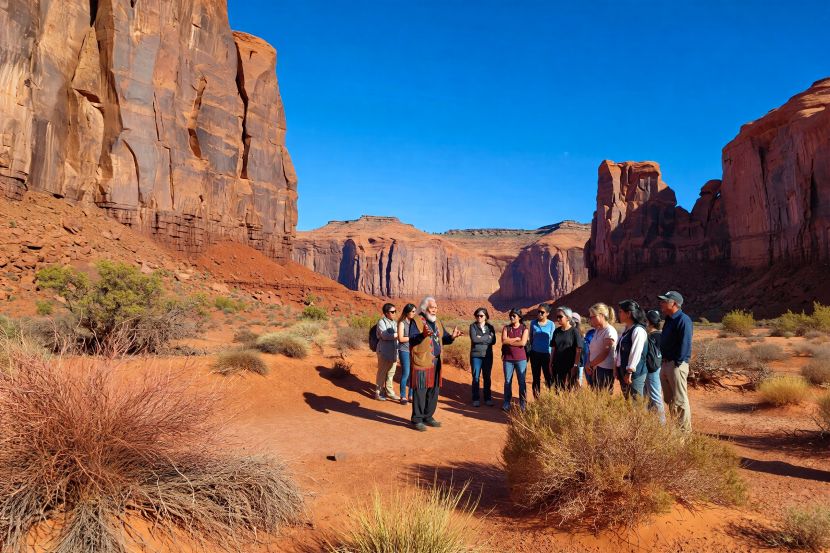Home » America Travel News » Indigenous Tourism in the United States: Embracing Culture and Community for an Authentic Travel Experience
Published on
November 17, 2025
The rise of Indigenous tourism in the United States is reshaping the way travellers experience American culture. Offering an immersive, authentic journey into Native American, Alaska Native, and Native Hawaiian communities, Indigenous tourism connects visitors with the rich traditions, heritage, and landscapes of Indigenous peoples. This growing movement is not just about sightseeing, it’s about preserving culture, controlling narratives, and creating economic opportunities for Indigenous communities.
What Is Indigenous Tourism and Why Is It Important?
Indigenous tourism is defined as travel experiences created by Indigenous communities, allowing them to share their culture, history, and lands through guided tours, cultural stays, and unique local experiences. The American Indigenous Tourism Association (AITA) defines it as a sector where Indigenous communities take the lead in curating how their stories and traditions are presented to the public.
This type of tourism is crucial for several reasons. It allows Indigenous communities to maintain control over their cultural narratives, ensuring their traditions are represented authentically and respectfully. Additionally, Indigenous tourism supports cultural heritage preservation while generating economic benefits. According to AITA, the Indigenous hospitality sector contributed approximately USD 11.6 billion to the U.S. economy, illustrating the sector’s increasing significance.
For communities, tourism offers an opportunity to share their cultural values with the world, fostering greater understanding and appreciation of Indigenous ways of life. As these communities thrive economically, they also gain more autonomy over how their heritage is showcased, ensuring that tourism benefits them directly and meaningfully.
What’s Behind the Growth in Indigenous-led Travel Experiences?
The growth of Indigenous tourism in the U.S. has been remarkable. From 2017 to 2020, the number of Indigenous-owned tourism firms increased by 228%, and employment in the sector grew by 78.2%. This growth is attributed to the increasing demand for authentic travel experiences. More and more travellers are seeking experiences that are rooted in local culture and that support sustainable and community-driven tourism practices.
Additionally, government and non-profit organisations have been instrumental in fostering this growth. The Native American Tourism and Improving Visitor Experience (NATIVE) Act supports the expansion of Indigenous tourism businesses by encouraging tribes to develop their own tourism strategies. As the tourism industry continues to recognise the value of these experiences, there is a growing focus on land stewardship and environmental respect, which aligns with Indigenous cultural practices.
Another key factor in the sector’s growth is the shift towards responsible tourism. Many visitors are now looking to make travel choices that support the local communities they visit. This aligns perfectly with Indigenous tourism, which encourages cultural sensitivity and supports local economies.
How You Can Experience Indigenous Tourism in the US
Indigenous tourism in the U.S. offers travellers numerous ways to explore, learn, and engage with Native cultures. Here are just a few of the top Indigenous-led experiences available:
1. Monument Valley (Arizona/Utah) – Navajo Nation Guided Tours
In Monument Valley, travellers can experience the heart of Navajo culture through guided tours that explore the iconic red sandstone buttes, sacred sites, and petroglyphs. These tours are led by Navajo guides who provide insights into the cultural significance of the land.
2. Page, Arizona: Antelope Canyon and Cultural Dinner Show
Visitors to Page, Arizona, can enjoy guided hikes through Antelope Canyon and evening Navajo dinner shows that feature storytelling, traditional drum music, and Indigenous cuisine such as fry-bread tacos. This combination of outdoor adventure and cultural immersion offers a unique look into Navajo traditions.
3. Alaska’s Southeast: Village-Based Cultural Tours
In Alaska, Native corporations and Indigenous communities offer cultural tours that showcase the rich traditions of Alaska Native peoples. For example, the Organized Village of Kasaan offers stays and cultural immersion, focusing on wilderness stewardship and hospitality rooted in local traditions.
4. South Dakota: Indigenous-Owned Ranch Stays
In South Dakota, visitors can stay at Indigenous-owned working ranches where they can engage in horseback riding, cultural education, and learn about land stewardship practices from the Lakota people. These ranch stays provide a direct, hands-on approach to understanding Indigenous values and traditions.
5. Reservations & Cultural Heritage Stays Across Multiple States
Many Indigenous tourism businesses across the U.S. offer unique lodging experiences, including stays at Indigenous-owned heritage lodgings and cultural programs that feature craft-making, traditional foods, and nature activities. The AITA provides detailed guides for these experiences across the country, helping travellers connect with local communities.
Best Practices for Supporting Indigenous Tourism
When engaging in Indigenous tourism, it’s important to follow best practices to ensure that the experiences are respectful and beneficial to the communities involved. Key guidelines include:
Support Indigenous-owned operations: Choose experiences that are run by Indigenous people or communities to ensure that profits and decision-making stay within the community.Respect cultural integrity: Look for experiences that authentically reflect Indigenous culture, land, language, and traditions.Promote economic sustainability: Ensure that your travel choices contribute to the local economy, creating long-term benefits for Indigenous communities.Respect land stewardship: Indigenous tourism often emphasises environmental care and conservation, aligning with traditional land management practices.Follow appropriate cultural protocols: Many Indigenous-led tours will educate visitors on how to behave respectfully in culturally sensitive spaces.A Growing Opportunity for Authentic Cultural Travel
Indigenous tourism in the U.S. offers an exciting opportunity for travellers to experience authentic, community-driven cultural experiences. As the sector continues to grow, it not only empowers Indigenous communities but also provides an enriching and meaningful way for visitors to learn about Native cultures, traditions, and history. From the stunning landscapes of Monument Valley to the cultural richness of Alaska and South Dakota, Indigenous tourism is a gateway to a deeper understanding of the country’s heritage and the people who have shaped it for centuries.
For those planning their next adventure, exploring Indigenous tourism experiences presents an opportunity to travel responsibly while supporting local communities and celebrating cultural diversity.

